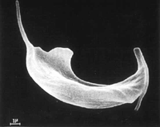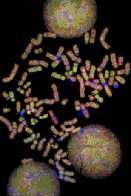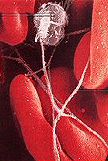![]()
![]()
Anaemia is a very common condition that is caused by an acquired or hereditary
abnormality of red blood cells to provide adequate oxygen supplies to
body tissues. The condition may be due to decreased number of red blood
cells, decreased amount of substance in red blood cells which transports
oxygen haemoglobin, or decreased volume of red blood cells. These may
all come about due to bleeding, dietary deficiency, malabsorption, systemic
illness, haemolysis, bone marrow failure or inherited abnormalities of
red cells. Anaemia generally causes a shortness of breath on exertion,
tiredness and headaches. There are many different types of anaemia including:
anaemia
of B12 deficiency
anaemia of chronic disease
anaemia of folate deficiency
drug-induced immune haemolytic anaemia
haemolytic anaemia
haemolytic anaemia due to g6pd deficiency
idiopathic aplastic anaemia
idiopathic autoimmune haemolytic anaemia
immune haemolytic anaemia
iron deficiency anaemia
megaloblastic anaemia
pernicious anaemia
secondary aplastic anaemia
sickle cell anaemia
Some of the anaemias can be cured whereas others have no cure. Supplementation with sublingual B-12 (dibencozide) along with folic acid, stimulates the bone marrow to raise the haemoglobin count signifigantly and which helps in certain anaemia cases. This method does not really help in anaemia where the red blood cells find it difficult to bind to oxygen.
![]()
 Sickle
Cell Anaemia is an hereditary disease resulting from a single amino acid
mutation of the red blood cells, a valine amino acid is substituted for
glutamic acid in both the beta chains of haemoglobin. People with sickle
cell disease have red blood cells that contain mostly an abnormal type
of haemoglobin.
Sickle
Cell Anaemia is an hereditary disease resulting from a single amino acid
mutation of the red blood cells, a valine amino acid is substituted for
glutamic acid in both the beta chains of haemoglobin. People with sickle
cell disease have red blood cells that contain mostly an abnormal type
of haemoglobin.
Sometimes the red blood cells become crescent shaped when the concentration of oxygen is low and if dehydrated. These 'sickle shaped' red blod cells have difficulty passing through small blood vessels and the cells can often block the vessels resulting in thrombosis. Individuals with sickle cell (heterozygous not homozygous form) seems to have a protective effect against the malaria parasite. There is currently no cure for blood borne sickle cell disease.
![]()
Leukaemia is often referred to as cancer of the blood, it is an malignant
condition that affects the immature blood-forming cells in the bone marrow.
There are different types of leukaemias:

 acute
leukaemias
acute
leukaemias
chronic leukaemias
lymphomas
multiple myeloma
The acute and chronic leukaemias usually start out in the bone marrow and before invading the blood can displace normal blood forming cells to such a degree that they present as anaemia. Eventually many tumour cells invade the blood and in certain leukaemias this is so severe that the bloody loses its normal red colour.
The lymphomas and multiple myeloma tend to form solid tumours in lymph glands, bone marrow or other tissues but often evolve into a leukaemic phase where the tumour cells invade the blood stream in large numbers.
![]()
 Thrombosis
is the formation of a blood clot in the heart or a blood vessel. Many
factors contribute tothrombosis including injury to a blood vessel's lining
from inflammation (thrombophlebitis) or atherosclerosis, blood flow that
is turbulent or sluggish, or coagulation abnormalities like from high
numbers of platelets or excessive fats in the blood. Thrombosis is a particular
danger after major surgery. Blood flow can be blocked at the point of
clot formation or break free to block it elsewhere, an embolism.
Thrombosis
is the formation of a blood clot in the heart or a blood vessel. Many
factors contribute tothrombosis including injury to a blood vessel's lining
from inflammation (thrombophlebitis) or atherosclerosis, blood flow that
is turbulent or sluggish, or coagulation abnormalities like from high
numbers of platelets or excessive fats in the blood. Thrombosis is a particular
danger after major surgery. Blood flow can be blocked at the point of
clot formation or break free to block it elsewhere, an embolism.
![]()
Haemophilia is an genetic blood disorder. Many proteins in the blood are
necessary for clotting of the blood, and deficiency of many of these can
result in blood not being able to form a firm clot and the individual
has a large tendency to bleed. Haemophilia A is due to lack of factor
VIII, and haemophilia B is due to lack of factor IX. In the UK haemophilia
A is about five times more common than haemophilia B. Haemophilia is an
inherited disease that is passed on through the female line in families.
In severe cases, the factor is completely missing from the blood whilst in less severe forms some factor is detectable in the blood but it is present in very low concentrations. Severe haemophilia is characterised by recurrent and spontaneous bleeding into joints, particular the knees, ankles and elbows. Bleeding may also occur into muscles, but this is usually after a knock or fall. Surprisingly bleeding from cuts or scratches stop quite quickly despite the lack ofa particular clotting factor. Internal bleeding causes a problem and is not easily spotted very quickly due to no presence of swelling early on.